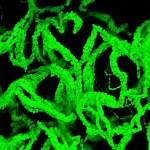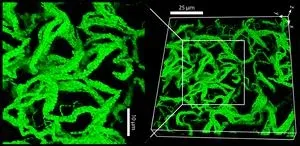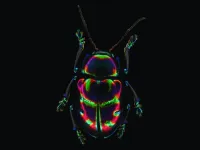(Press-News.org) Scientists at Caltech and Princeton University have discovered that bacterial cells growing in a solution of polymers, such as mucus, form long cables that buckle and twist on each other, building a kind of "living Jell-O."
The finding could be particularly important to the study and treatment of diseases such as cystic fibrosis, in which the mucus that lines the lungs becomes more concentrated, often causing bacterial infections that take hold in that mucus to become life threatening. This discovery could also have implications in studies of polymer-secreting conglomerations of bacteria known as biofilms—the slippery goo on river rocks, for example—and in industrial applications where they can cause equipment malfunctions and health hazards.
The work is described in a paper published on January 17 in the journal Science Advances.
"We've discovered that when many bacteria grow in fluids containing spaghetti-like molecules called polymers, such as mucus in the lungs, they form cable-like structures that intertwine like living gels," says Sujit Datta, a professor of chemical engineering, bioengineering, and biophysics at Caltech and corresponding author of the new paper. "And, interestingly, there are similarities between the physics of how these structures form and the microscopic physics underlying many nonliving gels, like Purell or Jell-O."
Datta recently moved to Caltech from Princeton University. One of his graduate students at Princeton, Sebastian Gonzalez La Corte, is lead author of the paper. He and Datta had been interested in how mucus concentration changes in the lungs and guts of cystic fibrosis patients—in whom more polymers than usual are present. Working with mucus samples provided by colleagues at MIT, Gonzalez La Corte grew E. coli bacteria (commonly used in laboratory studies) in regular liquid and in cystic fibrosis-like samples and then observed the specimens under a microscope to watch how the bacterial cells grew in each case.
He focused on cells that had lost the ability to swim, as is the case for many bacteria in nature. Under normal circumstances, when such a cell divides into two, the resulting cells separate and diffuse away from each other. However, Gonzalez La Corte found that in a polymeric solution, the copied cells remained stuck to each other, end to end.
"As cells continue to divide and stick to each other, they start to form these beautiful long structures that we call cables," Gonzalez La Corte says. "At some point, they actually bend and fold on each other and form an entangled network."
The team found that the cables continue to elongate and grow as long as the cells have the nutrients they need, eventually creating chains that are thousands of cells long.
Subsequent experiments showed that it does not seem to matter which bacterial species are introduced, nor does the type of organic polymer solution make a difference; once enough polymer surrounds the bacterial cells, the cables grow. The researchers even saw the same result with bacteria in synthetic polymers.
Although the initial motivation for the study was to better understand the growth of infections in patients with cystic fibrosis, the findings are more broadly relevant. Mucus plays an important role in the human body, not only in the lungs but also in the gut and in the cervicovaginal tract. And Datta says the work is also important in the context of biofilms, groupings of bacteria that grow an encapsulating polymer matrix of their own. There are biofilms in the human body, such as dental plaque, but they are also extremely common in soil and in industrial settings, where they can damage equipment and cause health hazards.
"That polymer matrix that they've secreted is what makes biofilms so tough to remove from surfaces and treat with antibiotics," Datta says. "Understanding how cells grow in that matrix could be key to discovering how to better control biofilms."
Understanding the Physics Behind the Cables
Through carefully designed experiments, the team found that the external pressure exerted by the polymers surrounding the dividing cells is what forces the cells together and holds them in place. In physics, such an attractive force that is under the control of an outside pressure is called a depletion interaction. Gonzalez La Corte used the theory of depletion interaction to create a theoretical model of bacterial cable growth. The model can predict when a cable will survive and grow in a polymeric environment.
"Now we can actually use established theories from polymer physics, which were developed for completely different things, in these biological systems to quantitatively predict when these cables will arise," Datta says.
Why Do the Bacteria Form These Cables?
"We discovered this interesting, unusual, very unexpected phenomenon," Datta says. "We can also explain why it happens from a mechanistic, physics perspective. Now the question is: What are the biological implications?"
Interestingly, there are two possibilities: The bacteria could be clumping together to form this network of living gel in an effort to make themselves larger and therefore more difficult for immune cells to engulf and destroy. Alternately, cable formation could actually be harmful to the bacteria. After all, the secretions from the host cause the bacteria to build the cables. "Mucus isn't static; for example, in the lungs, it's being constantly swept up by little hairs on the surface of the lungs and propelled upward," Datta says. "Could it be that when bacteria are all clumped together in these cables, it's actually easier to get rid of them—to expel them out of the body?”
For now, no one knows which possibility is correct, and Datta says that is what makes this project remain interesting. "Now that we have found this phenomenon, we can frame these new questions and design further experiments to test our suspicions," he says.
Additional authors on the paper, "Morphogenesis of bacterial colonies in polymeric environments," are Corey A. Stevens, Gerardo Cárcamo-Oyarce, and Katharina Ribbeck of MIT; and Ned S. Wingreen (BS '84) of Princeton University. Gerardo Cárcamo-Oyarce is now at the Pontifical Catholic University of Chile. The work was supported by the National Science Foundation, the National Institutes of Health, the Camille Dreyfus Teacher–Scholar Awards Program, the Pew Scholars Program in the Biomedical Sciences, the Eric and Wendy Schmidt Transformative Technology Fund, and the Princeton Catalysis Initiative.
END
Bacteria in polymers form cables that grow into living gels
2025-01-17
ELSE PRESS RELEASES FROM THIS DATE:
Rotavirus protein NSP4 manipulates gastrointestinal disease severity
2025-01-17
Researchers at Baylor College of Medicine and collaborating institutions have improved our understanding of how rotavirus, the most common cause of acute gastroenteritis in children, makes people sick. The study published in Science Advances is among the first to show that the rotavirus protein NSP4 is both necessary and sufficient for multiple aspects of rotavirus infection by disrupting calcium signaling not only within infected cells but also in nearby uninfected cells. These disruptions in calcium signaling affect rotavirus disease severity, providing new insights into how ...
‘Ding-dong:’ A study finds specific neurons with an immune doorbell
2025-01-17
Interleukin-1 (IL-1) is a key molecule involved in inflammation and plays an important role in both healthy and diseased states. In disease, high levels of IL-1 in the brain are linked to neuroinflammation, which can disrupt the body’s stress response, cause sickness-like behaviors, worsen inflammation by activating brain immune cells, and allow immune cells from the body to enter the brain. It also can lead to brain damage by causing support cells to produce harmful molecules. Elevated IL-1 levels are associated with mood disorders, ...
A major advance in biology combines DNA and RNA and could revolutionize cancer treatments
2025-01-17
Our genes contain all the instructions our body needs to function, but their expression must be finely regulated to guarantee that each cell performs its role optimally. This is where DNA and RNA epigenetics comes in: a series of mechanisms that act as "markers" on genes, to control their activity without modifying the DNA or RNA sequence itself.
Until now, DNA and RNA epigenetics were studied as independent systems. These two mechanisms seemed to function separately, each playing its own role in distinct stages of the gene regulation process.
Perhaps that was a mistake.
In a publication ...
Neutrophil elastase as a predictor of delivery in pregnant women with preterm labor
2025-01-17
Background and objectives
No previous study has been conducted in Nigeria on the role of neutrophil elastase in predicting preterm birth. The present study aimed to determine the role of the neutrophil elastase test in predicting birth in women with preterm labor.
Methods
The present prospective cohort study recruited 83 pregnant women with preterm labor between 28 and 36+6 weeks of gestation, and followed up these subjects for 14 days. The controls comprised 85 pregnant women without preterm labor. The cervicovaginal fluid was collected and tested using the neutrophil elastase test. Then, the sensitivity, specificity, and positive and negative predictive parameters were determined. ...
NIH to lead implementation of National Plan to End Parkinson’s Act
2025-01-17
WHAT:
With support from the U.S. Department of Health and Human Services (HHS) Office of the Assistant Secretary for Health (OASH), the National Institutes of Health (NIH) is leading the implementation of the Dr. Emmanuel Bilirakis and Honorable Jennifer Wexton National Plan to End Parkinson’s Act (P.L. 118-66), which was signed into law on July 2, 2024. This follows a delegation of authority from the Secretary of the Department of Health and Human Services to the NIH Director.
The act establishes a Federal ...
Growth of private equity and hospital consolidation in primary care and price implications
2025-01-17
About The Study: In this cross-sectional study, nearly one-half of all primary care physicians (PCPs) were affiliated with hospitals, while private equity-affiliated PCPs were growing and concentrated in certain regional markets. Relative to PCPs in independent settings, hospital-affiliated PCPs and private equity-affiliated PCPs had higher prices for the same services.
Corresponding Author: To contact the corresponding author, Yashaswini Singh, PhD, MPA, email yashaswini_singh@brown.edu.
To access the embargoed study: Visit our For The Media website at this link https://media.jamanetwork.com/
(doi:10.1001/jamahealthforum.2024.4935)
Editor’s ...
Online advertising of compounded glucagon-like peptide-1 receptor agonists
2025-01-17
About The Study: This cross-sectional study showed websites that sell compounded glucagon-like peptide-1 receptor agonists (GLP-1 RAs) often partially informed and sometimes misinformed potential consumers. Compounded medications contain the same active ingredients as in branded medications but may contain different inactive ingredients. Most websites did not disclose that compounded GLP-1 RAs were not FDA approved, although some suggested these drugs were FDA approved. Many websites provided limited safety information and unauthorized efficacy claims. Some ...
Health care utilization and costs for older adults aging into Medicare after the affordable care act
2025-01-17
About The Study: This study found modest evidence of reductions in out-of-pocket costs and improvements in health among adults entering Medicare after the Affordable Care Act. Insurance coverage and financial assistance should be preserved and enhanced to improve health and health care access among vulnerable older adults.
Corresponding Author: To contact the corresponding author, Renuka Tipirneni, MD, MSc, email rtipirne@med.umich.edu.
To access the embargoed study: Visit our For The Media website at this link https://media.jamanetwork.com/
(doi:10.1001/jamahealthforum.2024.5025)
Editor’s ...
Reading the genome and understanding evolution: Symbioses and gene transfer in leaf beetles
2025-01-17
With more than 50,000 described species, the leaf beetle family is distributed worldwide and represents about a quarter of the species diversity of all herbivores. Leaf beetles can be found to feed on almost all plant groups. They live in the rhizosphere, the canopy and even underwater. Many leaf beetles, such as the Colorado potato beetle, are notorious pests. Their species richness and global distribution highlight their evolutionary success, which is particularly astonishing given that leaves are a difficult food source to digest and provide unbalanced nutrients.
Researchers from the Department of Insect Symbiosis at the Max Planck Institute for Chemical ...
Brains of people with sickle cell disease appear older
2025-01-17
Individuals with sickle cell disease – a chronic illness where misshapen, sticky blood cells clump together, reducing oxygen delivery to organs – are at a higher risk for stroke and resulting cognitive disability. But even in the absence of stroke, many such patients struggle with remembering, focusing, learning and problem solving, among other cognitive problems, with many facing challenges in school and in the workplace.
Now a multidisciplinary team of researchers and physicians at Washington University School of Medicine in St. Louis has published a study that helps explain how the illness might affect cognitive performance ...



